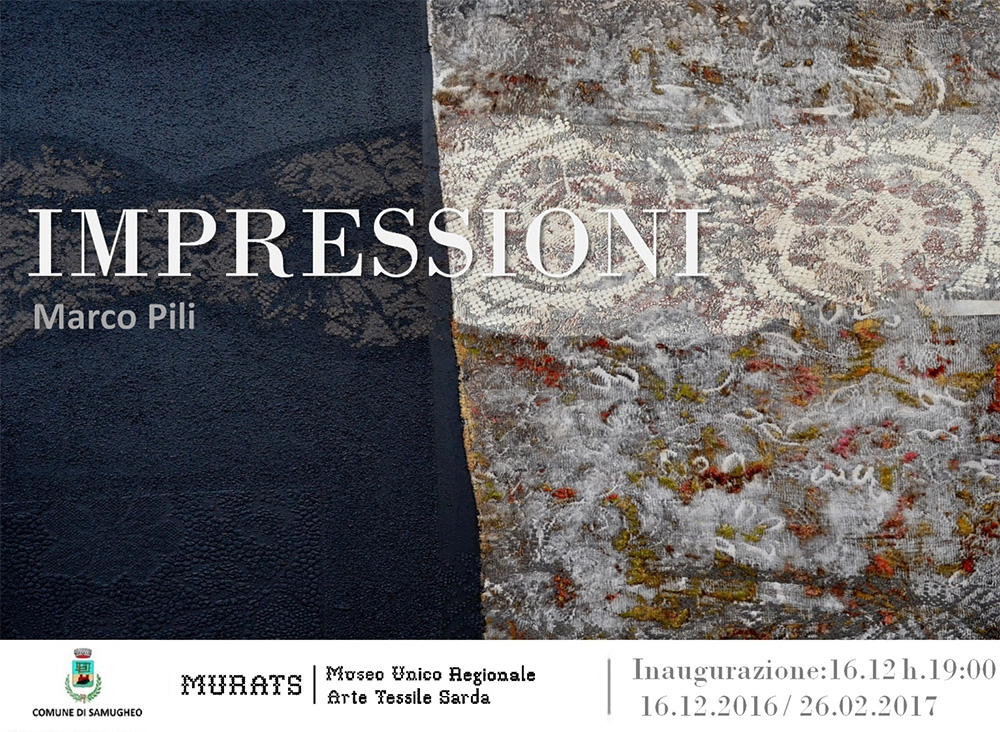
- On 18 Dec 2016
- By admin
- Tags Impressioni,marco pili,Mostra,murats,samugheo
Impressioni – Mostra a Samugheo
The City of Samugheo and Murats – Unique Regional Museum of Art Textiles Sarda, present the exhibition “IMPRESSIONS” to be held in the museum from 12.16.2016 to 02.26.2016,
The Murats – Regional Art Museum Unique Tessila Sarda Samugheo, closes the annual program with the exhibition “IMPRESSIONS”, the unique trip designed to create an intense and evocative dialogue between the ancient textile manufacture and contemporary art.
The exhibition, which is spread through the halls located in the ground floor of the museum, highlights refined and sensitive similarities between the pieces of the permanent collection and twenty paintings made by the artist Marco Pili, selected from around one hundred works from the series ” Ordius “, an original project started in 2015 and still in the making, born of the particular combination of materials and different artistic techniques. Mixed media decoupage sought meet textile and abstract pictorial languages décollage, to shape works of extraordinary evocative force, which are configured as a facilitator between painting, weaving and fiber art.
The artist’s paintings of Nurachi, hit for the extraordinary structural deconstruction and reprocessing of fabrics used to impart on the wire reliefs canvas, weft and warp.
The exhibition will be inaugurated on December 16 at 19:00 at the conference room of the Museum, in the presence of the Mayor Antonello Demelas Samugheo, the Director of Murats Baingio Cuccu and the artist and will be open until February 26, 2017.
Impressions is an act, an effect, an impression, an artistic process material processing, textile items that you do painting, painting that is done thread, weft, warp. Impressions are works created by strong gestures and decided, unloaded with intensity on the canvas, which conceal sophisticated contrast and harmony concepts.
The artist forces the material to express themselves, to be in a new, unexpected, absolutely unique. The canvas textile soul appropriates, which emerges from the surface renewed. With “Ordius” series, Marco Pili relates to techniques, assembly and combustion, leading to the dissolution of form.
The land-typical color dichotomy of his previous production, adds the textile element, which becomes significant work; works pigments and resins, reshapes the surface to create irregular bas-reliefs. Exempt from carpets, threadbare sheets and old fragments of tissue destined to be destroyed, the original value of handmade artifact, to breathe new life, renewed autonomy.
The artistic intervention occurs, then we lived on and worn objects, able to convey past memories, to reflect on the effects of time, manual on the act of those who made them. What was, it is now another, is elsewhere. Pili paints with fire, creates mixed media decoupage, “décollage” textiles, creates contamination and reciprocal influences to shape outcomes of extreme refinement, capable of superimposing powders, pigments, reliefs and abrasions, to fuse the textile and pictorial sign, a new , unpublished and harmonious dialogue.
Among the pieces on display and the incredible deep blue monochrome of very recent production, the son of a complex artistic process that harmoniously blends planning and randomness, resin and pigments, the artist’s hand and autonomy of the subject.
Marco Pili, born 1959, lives and works in Nurachi, the small village in the Sinai landscape that inspired it, and to whom he dedicates a lot of its own production works. Student of Antonio Love, studied at the Art Institute of Oristano, where he graduated in 1977. Six years later, in 1983, began its artistic activity: initially produces figurative paintings, a genre that he soon abandoned to deepen his personal research on abstraction.
Born the first combination of pictorial and material elements: sand, vegetable matter and synthetic resins, animal blood and carasau bread, everything is remodeled and reworked by the artist’s hands, to get canvas from the plastic surface, able to highlight the expressive qualities of materials used. The survey of Pili along the trail blazed by Alberto Burri, materialism is in fact the instrument and witness of the layered and multifaceted reality that surrounds him and of which the artist is the mouthpiece.
The search continues, develops, acquires further complexity with the introduction of new materials and different artistic tools: appear the fire and tissues, born the first combustion and textile décollage that today find their natural home in the Unique Regional Museum of Art Textiles Sarda, between the pieces of the historical collection of which the works of Marco Pili, represent an incredible new artistic evolution.
